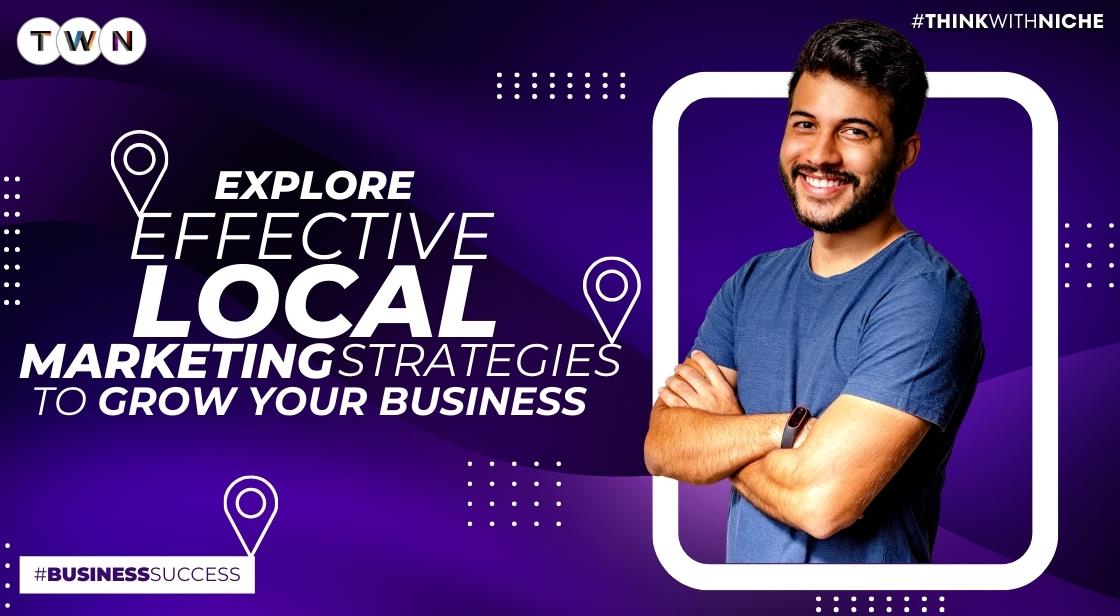Effective Local Marketing Strategies for Business Success

Blog Post
In today's competitive business landscape, local marketing strategies are more crucial than ever for businesses of all sizes to thrive. By understanding and implementing effective local marketing tactics, businesses can connect with their target audience, increase brand awareness, and drive customer engagement, ultimately leading to business growth and success.
These strategies are not merely optional but serve as the lifeblood for businesses aiming to carve their success within their immediate communities. By tapping into the power of local marketing, businesses can cultivate stronger connections, deepen customer engagement, and ultimately thrive in their local spheres.
Local marketing isn't solely about proximity; it's a finely tuned strategy that centers on engaging with the audience in close proximity to a business's physical location. From small mom-and-pop shops to larger enterprises, the ability to resonate with the local demographic becomes the linchpin for brand visibility, customer loyalty, and sustainable growth. In this comprehensive guide,
we'll delve into the myriad facets of effective local marketing strategies, uncovering the diverse tactics that can elevate a business's presence within its immediate community, regardless of its scale or industry.
In the digital age, where online presence is paramount, businesses often overlook the power of local marketing. However, local marketing remains a cornerstone of business success, particularly for small and medium-sized enterprises (SMEs) that rely on foot traffic and customer loyalty within their immediate vicinity.
Effective local marketing strategies enable businesses to establish a strong presence in their communities, building relationships with potential and existing customers, and fostering brand recognition.
These strategies encompass a range of tactics, from traditional methods like print advertising and local events to digital approaches like social media marketing and search engine optimization (SEO).
By tailoring their local marketing efforts to their specific location, businesses can effectively reach their target audience, understand their needs and preferences, and tailor their products and services accordingly. This localized approach not only strengthens customer relationships but also enhances brand reputation and trust.
What is local marketing?
Local marketing is a strategic approach that hones in on an audience residing within the immediate vicinity or a specific geographic area surrounding your business location. It's tailored to engage and attract potential customers who are within a reasonable distance, typically accessible by local travel means, and are likely to utilize your services or purchase your products.
For instance, imagine owning a boutique coffee shop in downtown Portland, Oregon. Focusing your marketing efforts on drawing in customers from New York City wouldn't be as beneficial as captivating the locals in Portland who could pop in for their morning coffee or a quick lunch break.
Travis McKnight, Senior Content Strategist at Portent Inc., emphasizes the pivotal nature of understanding your target demographic. Knowing their needs and the advantages your product or service offers enables effective communication of these benefits directly to your local audience.
In today's landscape, comprehending your audience isn't just essential; it's the cornerstone of a successful marketing strategy, especially in a local context where highlighting your business's proximity becomes key.
Efficient allocation of marketing resources is the primary goal of a local marketing strategy. While digital platforms offer an expansive reach, they need to be utilized effectively to resonate with local consumers. For a small local business, gaining traction within the community is vital. If the marketing efforts fail to connect with the local audience, regardless of their scale, they might yield minimal returns despite the investment.
In the current market scenario, local marketing has evolved significantly. Leveraging technology and data analytics, businesses can now harness the power of location-based targeting, refining their approaches to engage potential customers in specific areas. Integrating digital marketing strategies with local intent optimization, businesses can optimize their online presence to attract local customers actively searching for services or products within their vicinity.
Local marketing strategies remain paramount for businesses to efficiently allocate resources and connect with their immediate community. The blend of understanding local audience needs, effective communication, and harnessing digital tools tailored for local reach serves as the linchpin for local marketing success in today's dynamic business landscape.
Key Local Marketing Strategies for Business Success
1. Optimize Online Presence:
In today's digital age, your online presence is your business's storefront. Ensuring that your business is easily discoverable and visible online is crucial for attracting and retaining customers. Here are three key strategies to optimize your online presence:
1. Create and Optimize a Google My Business (GMB) Listing:
Google My Business (GMB) is a free tool that allows businesses to manage their online presence across Google Search and Maps. It's one of the most important factors for local SEO and can significantly impact your business's visibility in search results.
Key Steps:
-
Create a GMB listing if you haven't already.
-
Complete your profile with accurate and up-to-date information, including your business name, address, phone number (NAP), website, business hours, and services offered.
-
Verify your ownership of the listing to gain full access to its features.
-
Upload high-quality photos of your business, including your storefront, interior, and products or services.
-
Encourage customers to leave positive reviews on your GMB listing.
2. Optimize Website Content for Local SEO:
Local SEO is the process of optimizing your website to rank higher in search results for local searches. This means incorporating relevant local keywords into your website content, including your business name, address, phone number, and the products or services you offer in your specific location.
Key Steps:
-
Conduct keyword research to identify relevant local keywords that people in your area are searching for.
-
Use local keywords naturally throughout your website content, including page titles, meta descriptions, headings, and body text.
-
Build backlinks to your website from reputable local websites and directories.
3. Submit Business Information to Relevant Online Directories:
Online directories are another valuable source of local business listings. Submitting your business information to these directories can help increase your online visibility and attract new customers.
Key Steps:
-
Identify relevant online directories in your industry and location, such as Yelp, Yellow Pages, Bing Places for Business, and local business listings websites.
-
Create listings for your business on these directories, ensuring that your NAP information is consistent across all platforms.
-
Monitor and update your listings regularly to keep your information accurate and up-to-date.
Additional Tips for Optimizing Online Presence:
-
Utilize social media platforms: Create and maintain active social media profiles for your business to engage with your local community, share relevant content, and promote your products or services.
-
Engage in local online forums and groups: Participate in online discussions and forums related to your industry or local community to build relationships and establish your business as a thought leader.
-
Monitor online reviews and respond promptly: Respond to both positive and negative reviews in a professional and timely manner to address concerns and demonstrate customer care.
-
Track your online performance: Regularly monitor your website traffic, social media engagement, and local SEO rankings to identify areas for improvement and measure the effectiveness of your online marketing efforts.
By implementing these strategies, you can effectively optimize your online presence, attract more customers, and drive business growth in your local community.
2. Engage in Social Media Marketing:
In today's hyperconnected world, social media has become an indispensable tool for businesses to connect with their target audience, foster brand loyalty, and drive sales. However, effective social media marketing requires a strategic approach tailored to the local community and the specific social media platforms that resonate with them.
1. Focus on Local Social Media Platforms
Not all social media platforms are created equal. While global giants like Facebook and Instagram have a wide reach, they may not be the most effective platforms for connecting with your local audience. Instead, focus on social media platforms that are popular in your community, such as Nextdoor, a hyperlocal platform for neighborhoods, or local community groups on Facebook.
Example:
A local bakery in Austin, Texas, might prioritize sharing content and engaging with followers on Nextdoor, where they can connect with residents in their specific neighborhood, promote upcoming events, and showcase their delicious pastries.
2. Create and Share Targeted Content
Your social media content should be relevant to the interests and needs of your local audience. This means going beyond generic promotional posts and tailoring your content to resonate with the specific interests and events happening in your community.
Examples:
-
Share local news and updates relevant to your industry or business.
-
Highlight local events, festivals, and community initiatives.
-
Feature customer stories and testimonials from your local community.
-
Create engaging content that sparks conversations and encourages interaction, such as polls, quizzes, or contests.
3. Engage in Local Community Engagement
Social media is not just about broadcasting your message; it's about building relationships and engaging with your community. Actively participate in online groups, forums, and discussions related to your local area. Share your expertise, offer helpful advice, and contribute to the overall community dialogue.
Examples:
-
Join local Facebook groups related to your industry, such as a group for local businesses or a group for foodies in your area.
-
Participate in online discussions about local events, attractions, or topics relevant to your community.
-
Offer your expertise or insights to help others in the community.
Also Read: Five Steps To Creating A Digital Marketing Strategy
Additional Tips for Social Media Marketing:
-
Use relevant hashtags: Incorporate local hashtags to increase the visibility of your posts and reach a wider audience in your area.
-
Tag local businesses and influencers: Collaborate with other local businesses or influencers to expand your reach and tap into their established audience.
-
Run targeted social media ads: Utilize social media advertising platforms to target your ads to users in your specific geographic area.
-
Analyze your social media performance: Regularly track your social media metrics, such as engagement, reach, and follower growth, to identify what's working and what needs improvement.
By effectively engaging in social media marketing, businesses can connect with their local audience on a deeper level, build trust and loyalty, and ultimately drive business growth in their community.
3. Build Community Relationships:
In today's competitive business landscape, building strong community relationships is essential for long-term success. By fostering connections with local businesses, organizations, and the community at large, businesses can establish themselves as trusted partners and gain valuable support.
1. Partner with Local Businesses, Organizations, and Influencers
Collaborating with other local entities can significantly expand your reach and introduce your business to a wider audience. Seek out opportunities to partner with local businesses that complement your offerings, such as a non-profit organization that aligns with your values, or a local influencer who resonates with your target market.
Examples:
-
A local bakery partners with a coffee shop to offer a combo deal, attracting more customers to both businesses.
-
A clothing store sponsors a local fashion show, gaining exposure and showcasing their latest designs.
-
A restaurant hosts a customer appreciation night with live music and special menu items, expressing gratitude to their loyal patrons.
2. Sponsor or Participate in Local Events, Festivals, and Charitable Initiatives
Active involvement in local events demonstrates your business's commitment to the community and helps establish a positive brand reputation. Sponsor or participate in local festivals, fairs, charitable events, or community initiatives that align with your brand values.
Examples:
-
A local bookstore sponsors a community literacy event, promoting reading and supporting a worthy cause.
-
A pet store participates in an animal adoption drive, showcasing their love for animals and contributing to a meaningful cause.
-
A fitness center organizes a community health walk, promoting wellness and fostering connections within the community.
3. Show Appreciation to Loyal Customers
Loyal customers are the backbone of any business. Expressing gratitude to your regular patrons reinforces their loyalty and encourages them to continue supporting your business. Offer discounts, special promotions, or exclusive events to show appreciation for their patronage.
Examples:
-
A coffee shop offers a loyalty program that rewards frequent customers with free drinks and exclusive perks.
-
A hair salon hosts a customer appreciation event with complimentary hairstyling and refreshments.
-
A local retailer provides exclusive discounts and early access to new products for their loyal customers.
Additional Tips for Building Community Relationships:
-
Engage with the local community: Actively participate in online and offline community discussions, forums, and events to stay connected with the local community.
-
Respond to customer feedback: Promptly and professionally address customer feedback, both positive and negative, demonstrating your commitment to customer satisfaction.
-
Support local causes: Donate to local charities, sponsor local sports teams, or participate in community volunteer initiatives.
-
Promote local businesses: Recommend other local businesses to your customers, creating a sense of camaraderie and support within the community.
4. Hyperlocal Marketing:
-
Geofencing: Utilize geofencing to target mobile ads to users within specific geographical areas.
-
Hyperlocal Content: Create and share content tailored to specific neighborhoods or micro-communities.
-
Local Partnerships and Sponsorships: Partner with local businesses and organizations in specific neighborhoods.
5. Traditional Local Marketing:
-
Print Advertising: Utilize local newspapers, magazines, and community newsletters to reach a wider audience.
-
Local Events and Sponsorships: Participate in local events, fairs, and festivals to increase brand visibility.
-
Direct Mail: Send targeted direct mail campaigns to residents in the local area.
6. Customer Reviews and Feedback:
-
Encourage Online Reviews: Encourage customers to leave positive reviews on Google My Business, Yelp, and other platforms.
-
Respond to Reviews: Respond promptly and professionally to both positive and negative reviews, demonstrating responsiveness and customer care.
-
Actively seek customer feedback through surveys, online forms, or in-person conversations to improve products, services, and overall customer experience.
Conclusion
In today's competitive business landscape, effective local marketing strategies stand as the linchpin for businesses to resonate with their immediate communities. Tailoring a blend of traditional and digital tactics, optimizing online presence, engaging on social media, fostering community relationships, and embracing hyperlocal methods are pivotal. By crafting a unique approach aligned with industry, audience, and location, businesses can cultivate lasting customer connections, drive brand loyalty, and ultimately triumph in their local markets.
You May Like
EDITOR’S CHOICE












